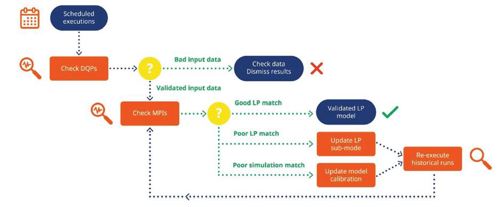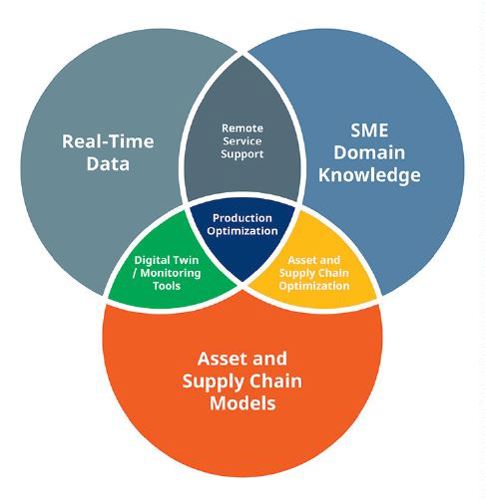2021 AFPM Summit Virtual Edition: Digital twin for refinery production optimization
CRISTINA AGUILAR GARCIA, Optimization and Simulation Advisor, Repsol, Madrid, Spain
Digitalization is fundamental to Repsol’s current strategy and as the company moves forward. To meet emerging challenges, the company has developed an ambitious program comprising numerous projects. Within Repsol’s Industrial Business, the development of digital twin for refinery processes leads the digitalization program. The digital twin maximizes production while optimizing energy consumption.
At Yokogawa’s “Y-NOW 2020: DX Solutions for Tomorrow” event, the author described the project in which a digital twin has improved the accuracy and scope of the refinery linear programming (LP) model that makes decisions regarding crude feedstock purchasing and refinery unit operations.
Key objectives. Repsol devised the project to increase the accuracy and frequency of updates for their planning models to improve decision-making. A cross-functional team—consisting of personnel from Repsol and KBC (A Yokogawa Company)—developed the technology. The initial project took place in a fluidized catalytic cracking unit (FCCU) at a refinery in northern Spain.
The team deployed a digital twin that combines KBC’s Petro-SIM first principles model with the OSIsoft PI System historian and dashboards. Key objectives included simplifications in terms of workflow, the planning model and model evaluation. By automating data collection and processing, the digital twin enables a greater focus on analyzing results rather than generating data. It also provides indicators that can be monitored immediately to check the health of LP vectors and the simulation model compared to actual process conditions.
To simplify the planning model, the digital twin can, if necessary, update the LP vectors based on the rigorous Petro-SIM model. The digital twin also provides model assurance through early detection and notification of relevant deviations between actual data and LP vector results.
A “single version of the truth” was another key objective. The digital twin provides access not only to the process and lab data, but also to derived indicators that can be used throughout the organization.
Implementing the solution. The key technologies are Petro-SIM and PI Vision. Petro-SIM is a digital twin that is based on a first principles model originally used for process simulation. Deployed in a back-casting prediction mode, it provides the calculation of critical operating parameters that allow an improved understanding and monitoring of the process. It is sensitive to changes in feeds, operating conditions, catalyst used and fractionation. It also provides updated calibration generation for the digital twin.
Petro-SIM generates indicators to monitor input data quality, reality vs. model results (LP vector and simulation model), and the health of the tool. If there are deviations, it also generates new LP vectors based on monitoring criteria. The model is automatically run on a regular basis, as required—typically daily or weekly. Data transfers between Petro-SIM and the PI System are bi-directional.
The differences between a digital twin and a traditional simulator are worthy of review. The digital twin is a replication of the actual process, and it allows for improved operation and understanding of the facility. While a simulator provides an accurate representation of a particular operating case, the digital twin is an accurate representation of the asset over its full range of operation. Rather than a snapshot in time, the digital twin captures the full history and the future of the asset.
Rather than being built on an ad-hoc basis to answer a particular question, the digital twin is automated. Its regular model runs are built into business workflows. As a centralized, single version of the truth, the digital twin is used by everyone. Outputs are delivered directly to the business and enable strong corporate governance. The simulator, on the other hand, is typically owned and used only by isolated departments or groups.
Implementation of the solution required the team to integrate the data from the historian into the model and identify missing data. To identify systematic issues, the team conducted testing based on the historical data and evaluations of failed simulation runs. That enabled the development of trapping error mechanisms to run every week and allowed the team to complete the integration of the LP model and development of an LP update tool.
PI Vision provides dashboards that can incorporate results from Petro-SIM alongside other PI data. The displays were developed to allow users to best follow the desired workflow. The digital twin generates a great deal of information that various stakeholders can use in many ways.
By using customized displays, Repsol can ensure adherence to a consistent procedure (FIG. 1). Users can generate alerts to relevant deviations or data quality. Expert users can perform deeper analysis through direct interaction with Petro-SIM.

FIG. 1. Workflow calls for regularly scheduled execution of the digital twin with validation checks on data quality parameters (DQPs), KPI checks, LP model validation and, if necessary, LP model updating and recalibration.
Takeaway. In addition to the experience of subject matter experts (SMEs), most decision-making activities related to improving plant profitability—such as scheduling, planning, real-time operations and retrofitting—rely on a process model. Changing from traditional simulation to a digital twin solution ensures the best decision-making over time.
The digital twin can accelerate the identification and resolution of unit issues and improve productivity. The centralized solution provides information to all stakeholders throughout the organization with no need for advanced knowledge of the simulation model (FIG. 2). It also provides a unified template from which all teams and business units can discuss issues, such as model updates and data quality, and constitutes a single source of the truth that drives the alignment of decisions and actions across the value chain.

FIG. 2. The centralized solution provides information to all stakeholders throughout the organization.
ABOUT THE AUTHOR
Cristina Aguilar Garcia is a Technical Advisor with 20 years of industry experience in the fields of refinery optimization and simulation, including work on digitization projects. She teaches process simulation as a Repsol Master to the refinery and headquarters teams. In 2001, Ms. Garcia joined Repsol in the Technology Lab as a refinery research technician carrying out work in pilot plants and the laboratory. In 2004, she began work in the Calculation and Simulation Area, Distillation Units and Crudes, with responsibility for the technological area of distillation from 2012–2014 and the technological area of refining models from 2012–2016. In 2016–2017, she became Head of Programming and Optimization in Repsol TechLab, coordinating the activities of crudes assays, models, distillation, energy efficiency, optimization, environmental and regulations. Ms. Garcia holds a degree in chemical engineering from Complutense University of Madrid.







Comments